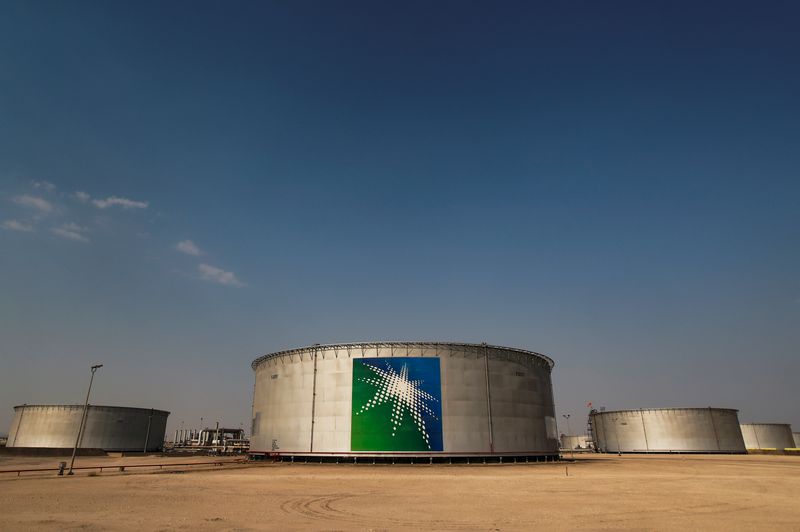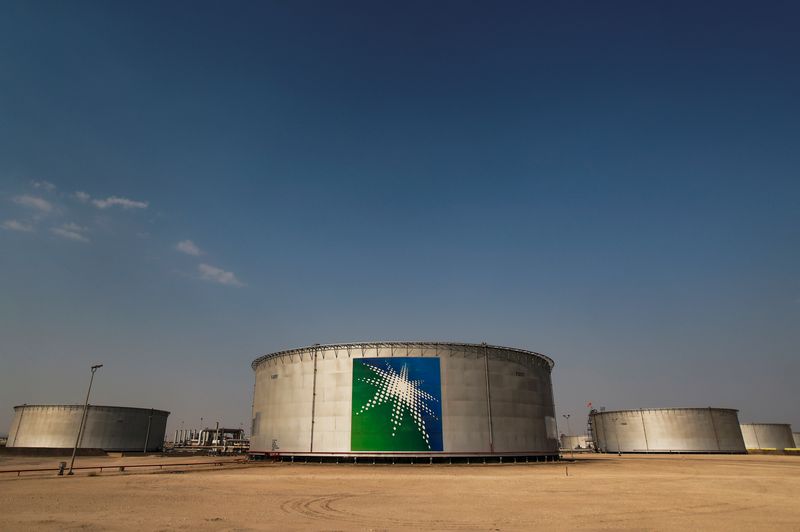Commodities
Oil falls further as demand uncertainty outweighs OPEC+


© Reuters. FILE PHOTO: A view shows branded oil tanks at Saudi Aramco oil facility in Abqaiq, Saudi Arabia October 12, 2019. REUTERS/Maxim Shemetov/File Photo
By Paul Carsten
LONDON (Reuters) -Oil prices dropped on Thursday, extending the previous session’s sharp losses as an uncertain demand outlook overshadowed an OPEC+ panel meeting deciding to maintain oil output cuts to keep supply tight.
futures had fallen 65 cents to $85.16 a barrel by 1245 GMT, while U.S. West Texas Intermediate crude futures were 75 cents lower at $83.47. Both benchmarks fell by more than $1 in earlier trading.
“Currently economic malaise is in the forefront of thinking and is the main price driver. The strong dollar, sluggish equity markets and rising bond yields are souring investor’s sentiment in energy,” said Tamas Varga of oil broker PVM in a note.
Oil settled more than $5 lower on Wednesday – its biggest daily drop in over a year – as a bleaker macroeconomic outlook and fuel demand destruction came into focus following a meeting of an OPEC+ panel, grouping the Organization of the Petroleum Exporting Countries and allies led by Russia.
The OPEC+ ministerial panel made no changes to the group’s oil output policy, and Saudi Arabia said it would continue with a voluntary cut of 1 million barrels per day (bpd) until the end of 2023, while Russia would keep a 300,000 bpd voluntary export curb until the end of December.
The Kremlin also said there was no deadline on lifting a ban on fuel exports to fight high local gasoline and diesel prices.
“We continue to see the market in deficit through the fourth quarter and the softer prices reduce the probability OPEC will ease supply constraints,” National Australia Bank (OTC:) analysts said.
On the downside, the euro zone economy probably shrank last quarter, according to a survey which showed demand fell in September at the fastest pace in almost three years as consumers reined in spending amid rising borrowing costs and prices.
The latest data also showed a sharp decline in U.S. gasoline demand. Finished motor gasoline supplied, a proxy for demand, fell last week to about 8 million bpd, its lowest since the start of this year, the U.S. Energy Information Administration (EIA) reported on Wednesday.
The U.S. services sector slowed in September as new orders fell to a nine-month low, though the pace remained consistent with expectations for solid third quarter economic growth.
Meanwhile, a pipeline from Iraq through Turkey, which has been suspended for about six months, is ready for operations, the Turkish energy minister said on Thursday.
Commodities
Oil prices rise; U.S. crude inventories plunge, Russia-Ukraine truce eyed
Commodities
India’s Reliance to stop buying Venezuelan oil over US tariffs, sources say
Commodities
Oil prices climb on Venezuela supply worries

 Forex3 years ago
Forex3 years agoForex Today: the dollar is gaining strength amid gloomy sentiment at the start of the Fed’s week

 Forex3 years ago
Forex3 years agoUnbiased review of Pocket Option broker

 Forex3 years ago
Forex3 years agoDollar to pound sterling exchange rate today: Pound plummeted to its lowest since 1985

 Forex3 years ago
Forex3 years agoHow is the Australian dollar doing today?

 Cryptocurrency3 years ago
Cryptocurrency3 years agoWhat happened in the crypto market – current events today

 World3 years ago
World3 years agoWhy are modern video games an art form?

 Commodities3 years ago
Commodities3 years agoCopper continues to fall in price on expectations of lower demand in China

 Economy3 years ago
Economy3 years agoCrude oil tankers double in price due to EU anti-Russian sanctions























